Hello lovely readers! I’m writing this on Wednesday evening, which means I’ve just gotten home from a big day on the farm. Wednesday is our CSA day–it’s the day the subscribers to our Community Supported Agriculture shares get to take home their weekly bins of freshly picked and cleaned veggies. The best day of the week!
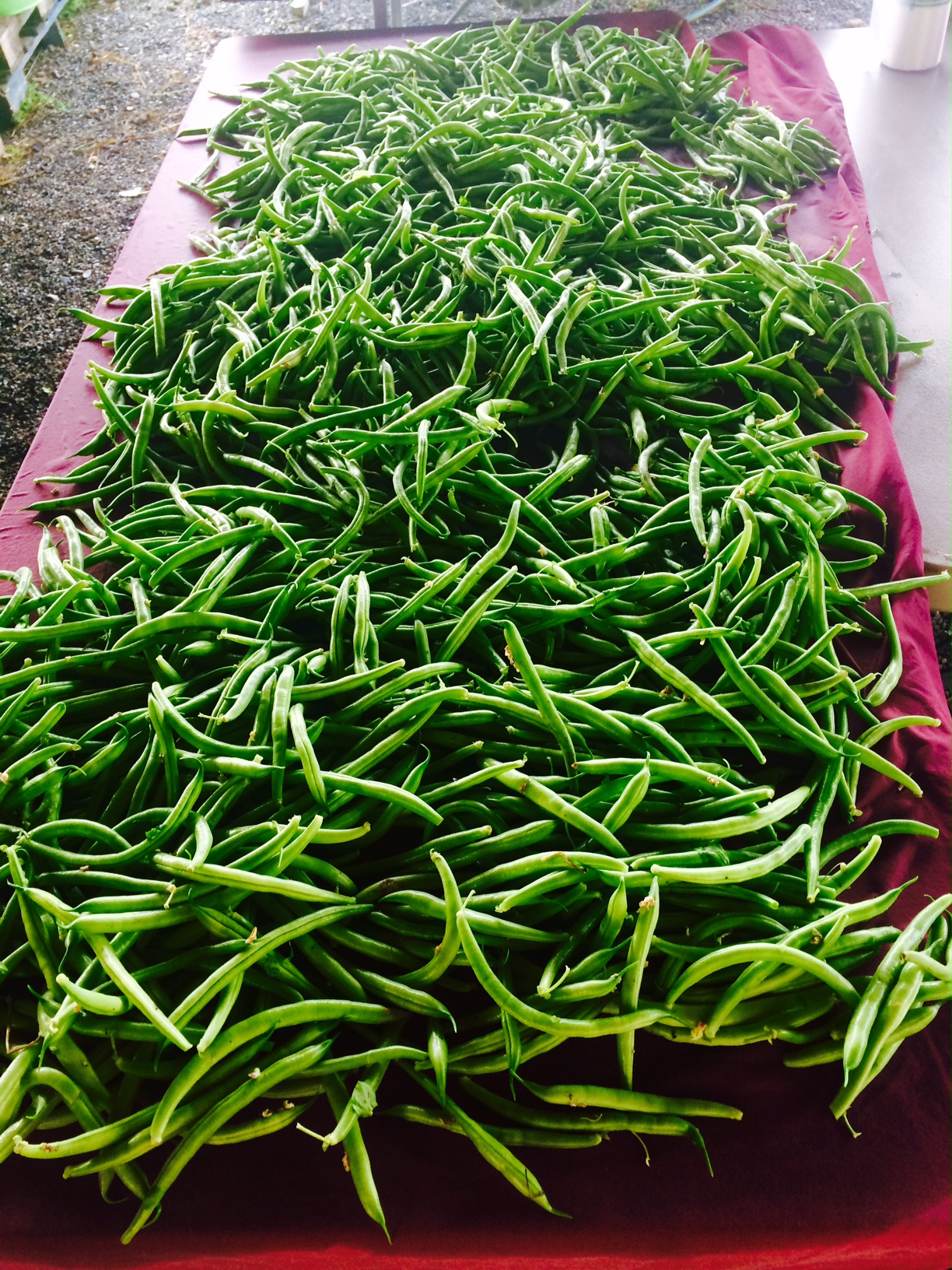
This year, Sun Circle Farm provides weekly shares for 39 lucky families. Some farms do clever or funny names for their different sized shares, but we stick to the basics: large and small. There are 26 large shares and 13 small in total. The large shares usually have 11 or 12 types of produce and two herbs per week. The small have 6 types of produce and one bunch of herbs. Everybody gets one share per week for 18 weeks from mid June through early October (give or take a week depending on late and early season weather). We take the week of the 4th of July off.
It’s great to see and experience how the shares evolve throughout the season. In June and early July the shares are very green and leafy! They are full of cutting greens, green onions, lettuce heads, napa cabbage, rhubarb, and early roots like radishes and salad turnips. As the season progresses heartier veggies start making appearances like broccoli, cauliflower, kale, carrots, cabbage, cucumbers, onions, beans, peas, and zucchini. Then comes beets, tomatoes, potatoes, and peppers. Finally, in the late season we see some of my favorites: brussels sprouts, rutabaga, winter squash, and leeks. Of course there are plenty of others that are in there, as well. Most of the veggies that make their appearance stay on the scene until the end of the season.

Today was a fun harvest day. The summer has been SO dry up until last week, which has been pretty stressful. Even though the season started early, a lot of plants have been water stressed (even with irrigation!). It’s great to see how much improvement has come with just a few good rainfalls. The wimpy carrots and beets are not so wimpy anymore, they are beautiful! The slugs are liking the rain, too…
Anyhow, we were down one worker today, so it was a little bit stressful at first. But you know those stress hormones–they get you moving pretty quickly. So, we ended up finishing with plenty of time to spare.
Here was my schedule today as a CSA worker:
10:00 a.m. Arrive and begin harvesting!
It may seem like a late time to arrive for a farming job. I guess it is. But you have to remember that in Alaska it is light for.ev.er. We go to bed pretty late. On some days I work until 8:00 or 8:30. Also, the mornings in the spring and fall are often cold enough that the hoses are frozen until about noon.
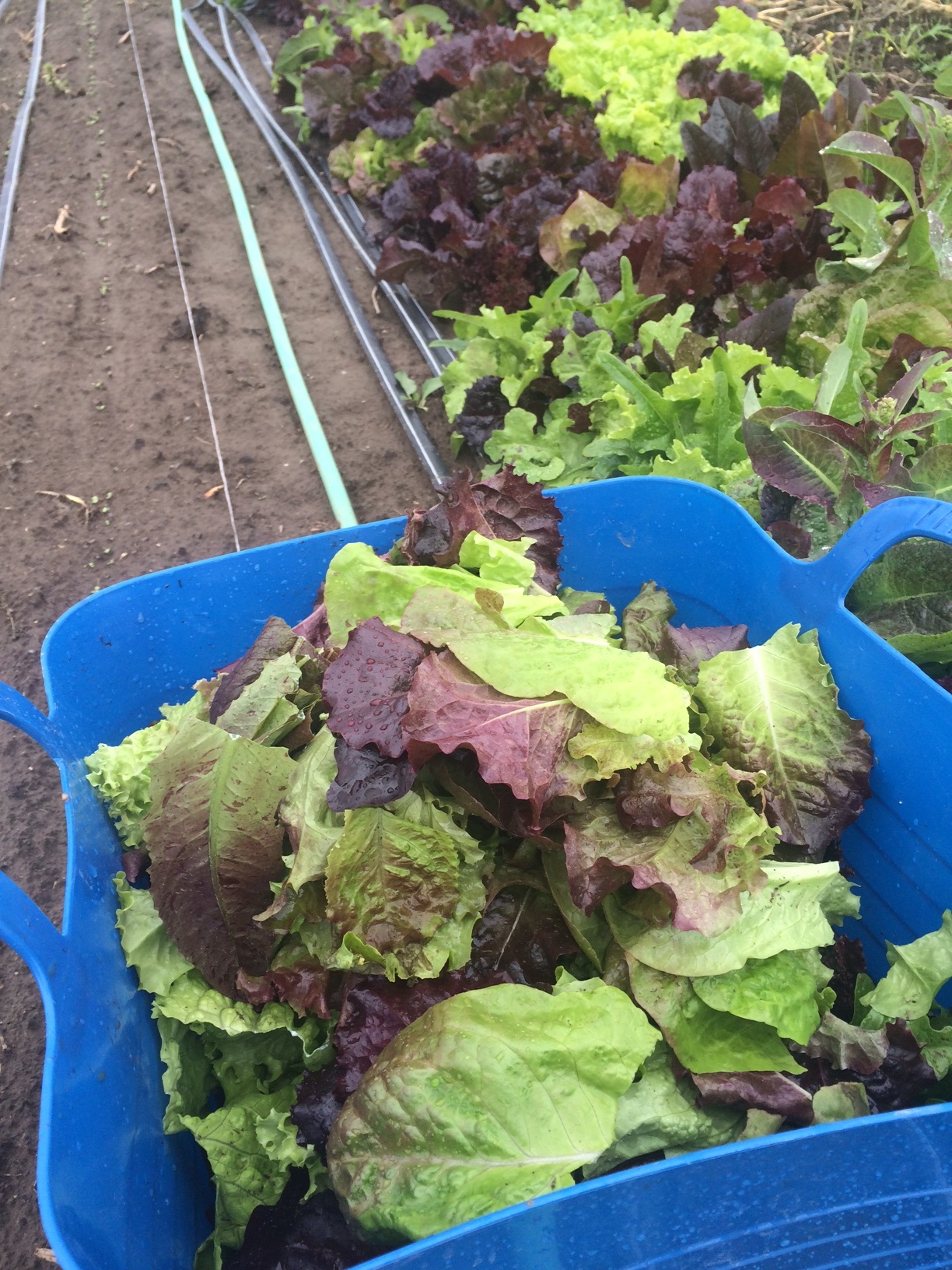
I look at the harvest list for the day. Anne-Corinne, the farmer, tallies up the total number of shares that need to be harvested for for each vegetable. We offer substitutes to members so this can be a bit involved. I’m glad she does the confusing part. One of the workers stays in the harvest shed for the entire day. She cleans and sanitizes various bins, tables, and tools. She also spins all of the greens, helps process and clean other veggies and weighs and bags almost all of the produce that has to be bagged. We always start off with cutting greens because they take quite a while to clean, weigh and bag. I started on our awesome salad mix! It has baby lettuce, three types of mustard greens, baby kale, beet greens, baby chard, tatsoi (an asian green similar to bok choi) and arugula. It is so delicious and beautiful. We only needed 23 pounds of it because it was only going to the large shares and several had substituted other produce for it. We have to compensate for water weight, so with the rain we harvested several extra pounds. Of course, today of all days, I cut myself for the first time all season! It wasn’t terrible, but it takes a while to sanitize everything and get bandaged up properly after a cut.
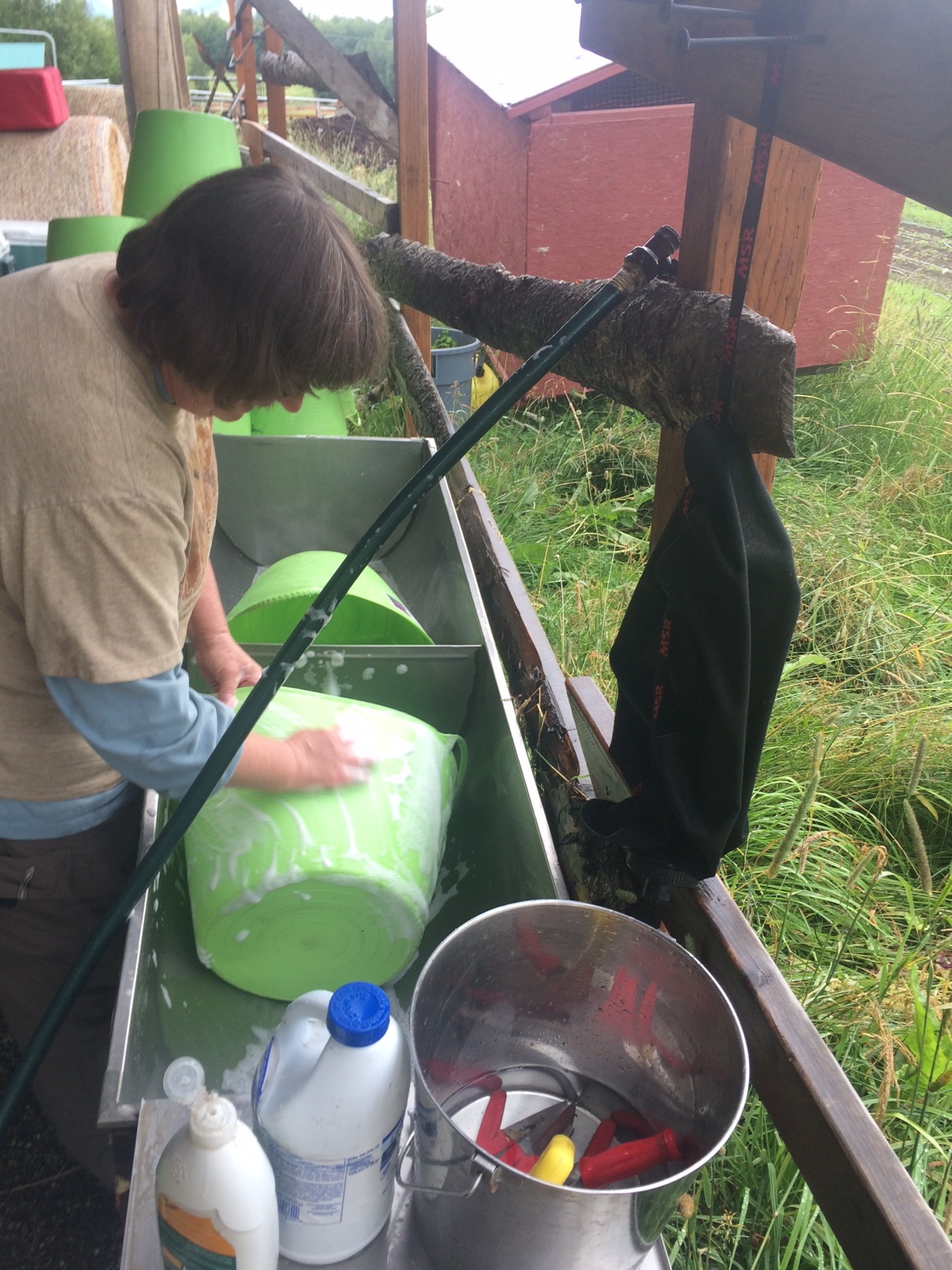
10:30 a.m. Harvest roots
Roots are almost always next because they, too, take forever to soak and clean. Erin, another worker, harvested beets while I harvested carrots. Alaskan carrots are some of the most delicious things on this whole amazing planet, so nobody requested substitutions for their carrots. 39 shares of carrots at eleven carrots per bunch equals a lot of carrots: 429 to be exact. Elementary school math proves useful once again! Harvesting nearly five hundred carrots actually doesn’t take that long, it’s the cleaning that is never ending.
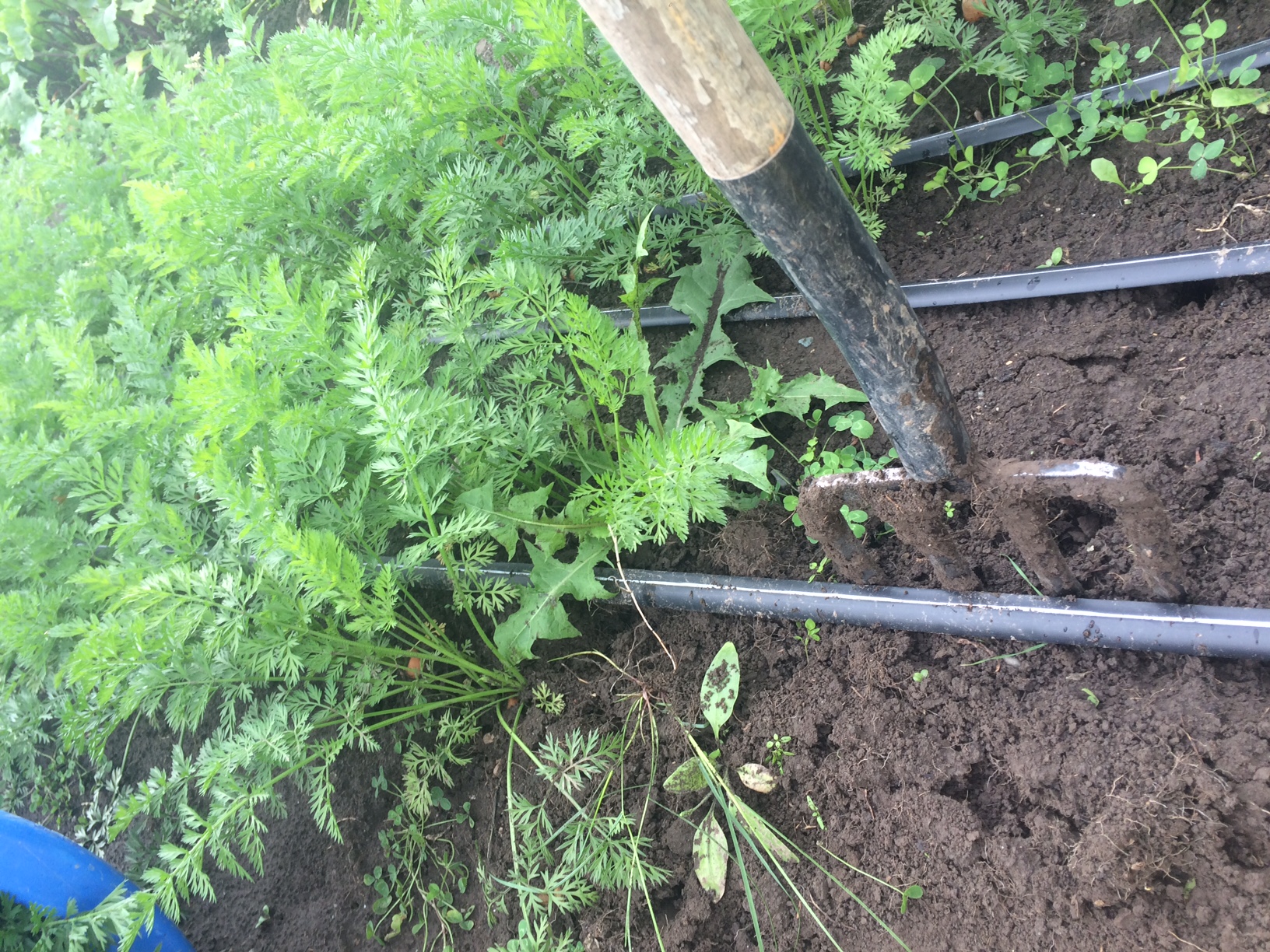
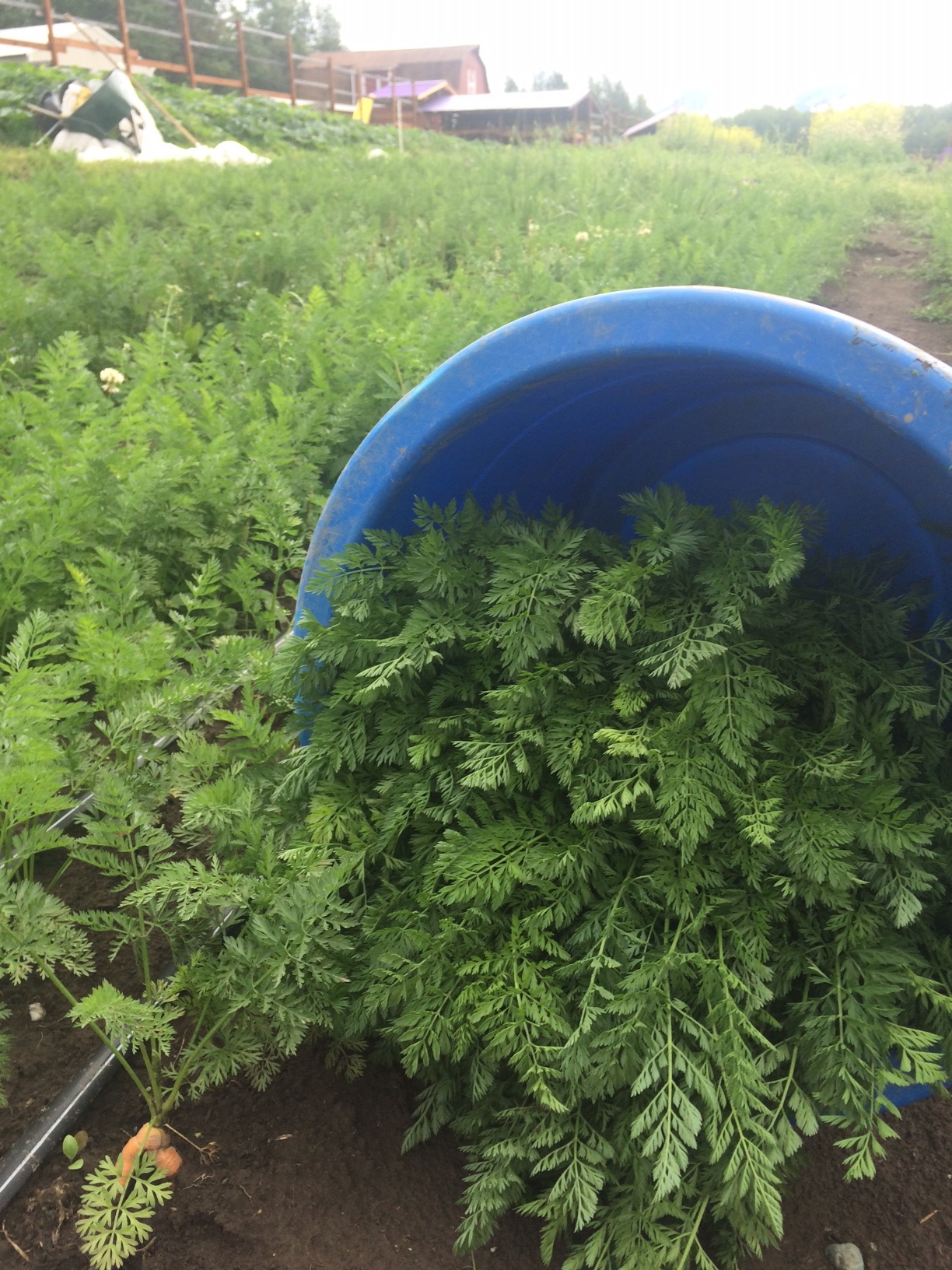
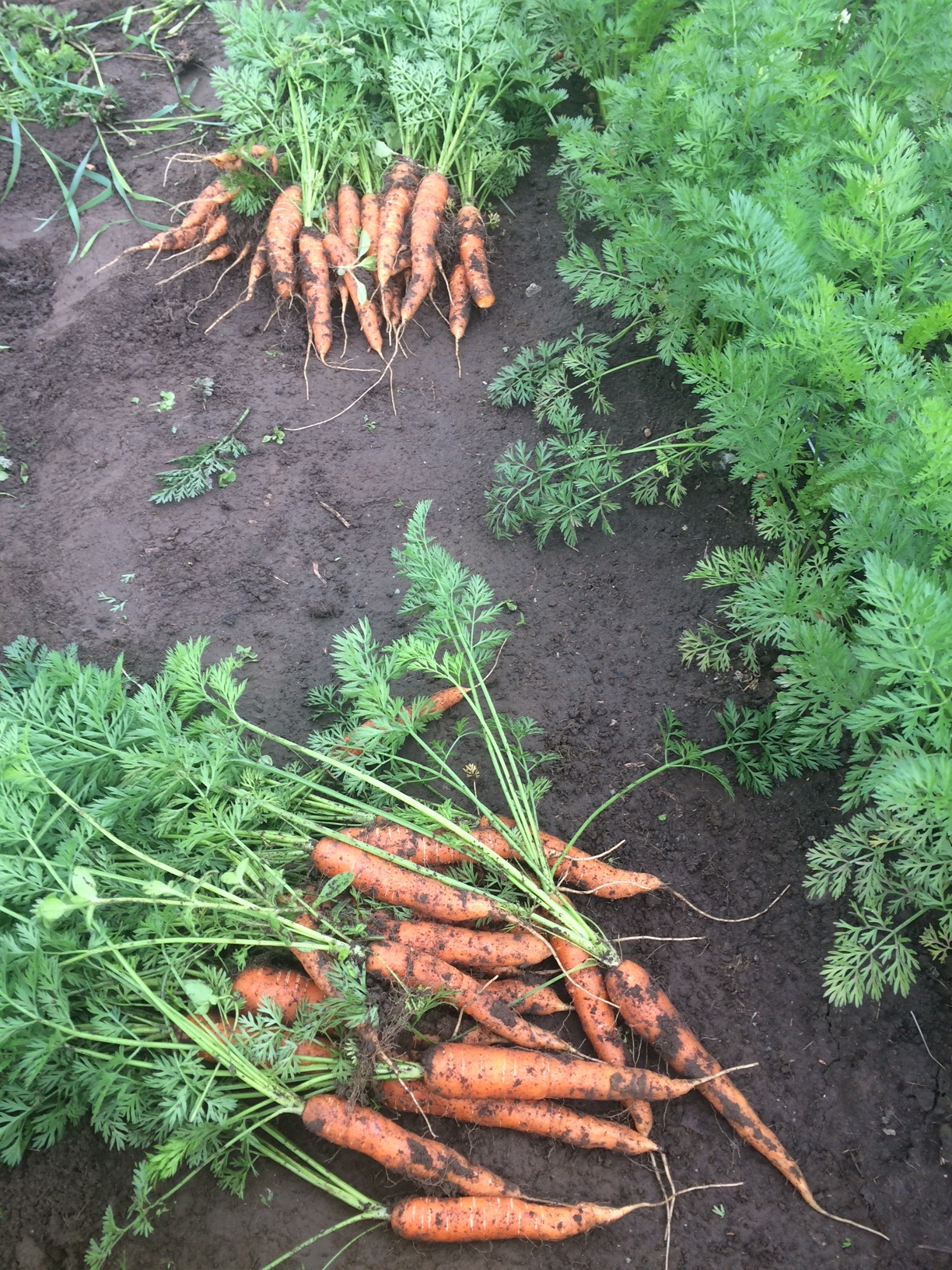
11:00 a.m. Harvest Zucchini from Squash Jungle
Each large share got two good sized zucchini. No substitutions, so fifty eight zucchini in all. I took on this task because I kind of enjoy the hunt for zucchini. They are sneaky things, aren’t they? You miss one and the next day it will be the size of your leg. Because of the long hours of sunlight the plants get HUGE. I pretty much just crawl through some of the sections because the plants are chest high and the spines hurt so much to reach through that it’s easier that way. It does feel jungle like with the huge leaves, encroaching winter squash tendrils, and beautiful squash blossoms. It’s also quite funny when an unsuspecting co-worker is startled by your camouflage. When I’m done, I bring them to the harvest shed and recount them as I place them in a clean washing bin to soak for a bit. I have to clean my harvest bin and knife pretty thoroughly to get rid of the zucchini slime.
12:00 p.m. Lunch
Ava comes up to me saying, “Hungy! Hungy!” and holding her tummy. It’s lunch time! I’m still full of the aforementioned stress hormones and not very hungry, but I set her up with her lunch and munch on a few things myself. Her awesome “babysitter” ten-year old Leila hangs out with her while I’m working. They have a great time reading, exploring and playing dress up. I really only have to step in when it’s time to eat or change diapers. Pretty great set up!
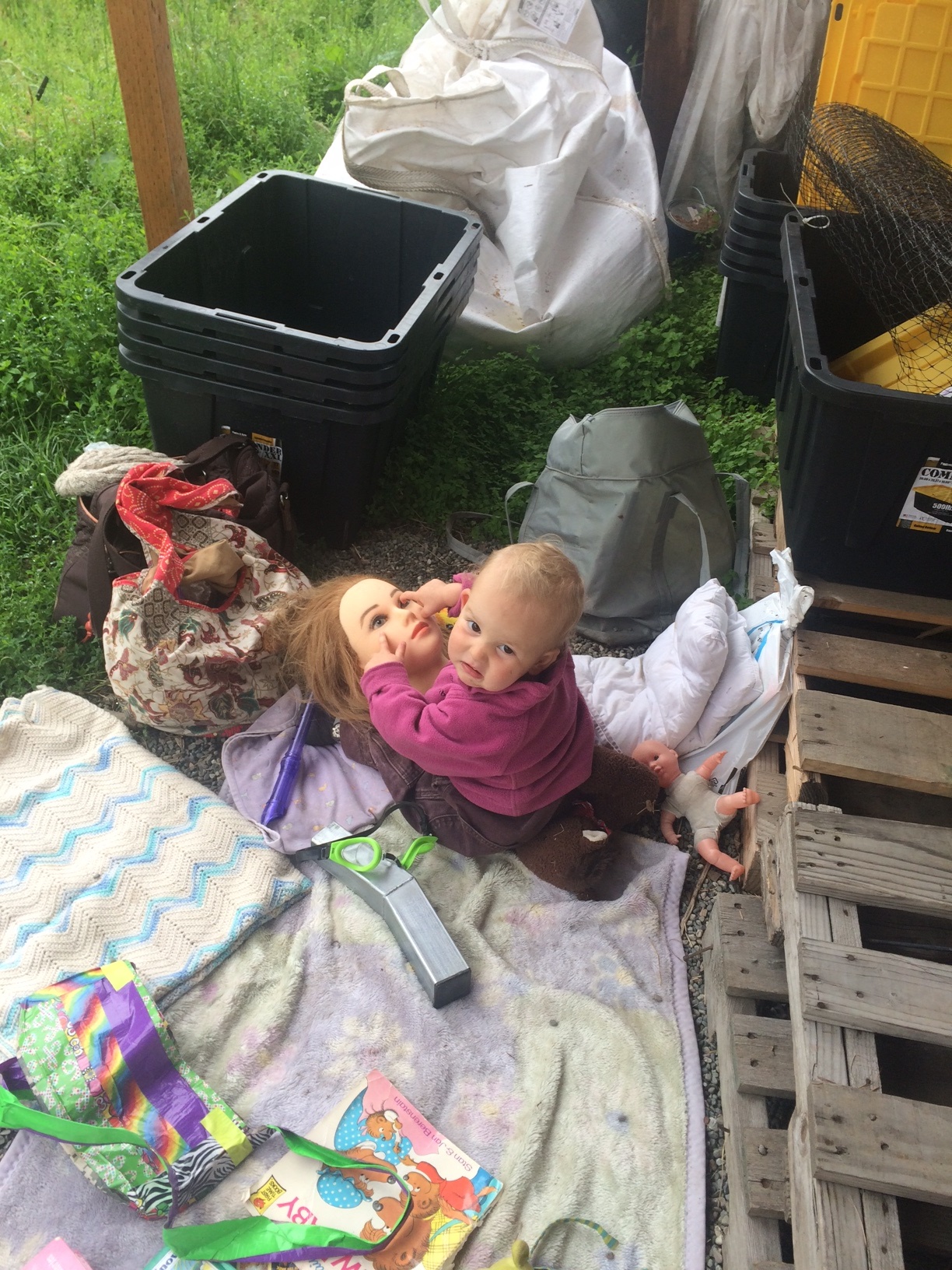
12:15 p.m. What’s Left?
We are almost done with our main harvest list at this point. I have harvested salad mix, carrots and zucchini. Anne-Corinne has gotten sugar snap peas, beans and arugula, Erin has gotten beets, celery and is working on basil. Trillium, one of the farmer’s daughters, has harvested broccoli, cabbage and cucumbers. The only remaining items are substitutions and thyme. I tackle the substitutions list while the others start cleaning roots and other produce.

Harvesting for the substitutions can be interesting because it’s generally only enough of each veggie for just a few shares. I end up getting three bunches of green onions, one bunch of spring onions, two bunches of radishes, three bunches of salad (hakurei) turnips, six heads of bok choi, three cauliflower heads, sixteen hot peppers, five pounds of spinach and a few extra cabbages to replace the ones that Trillium had to set aside because of slug damage. I have to write it all on my hand to keep track of what I’m heading out for. I also have to plan my route strategically so that the heaviest produce is on the bottom of the harvest bin and super dirty produce (like the onions and roots) don’t end up in the same harvest bin as the cleaner produce (like peppers).
1:00 Processing vegetables
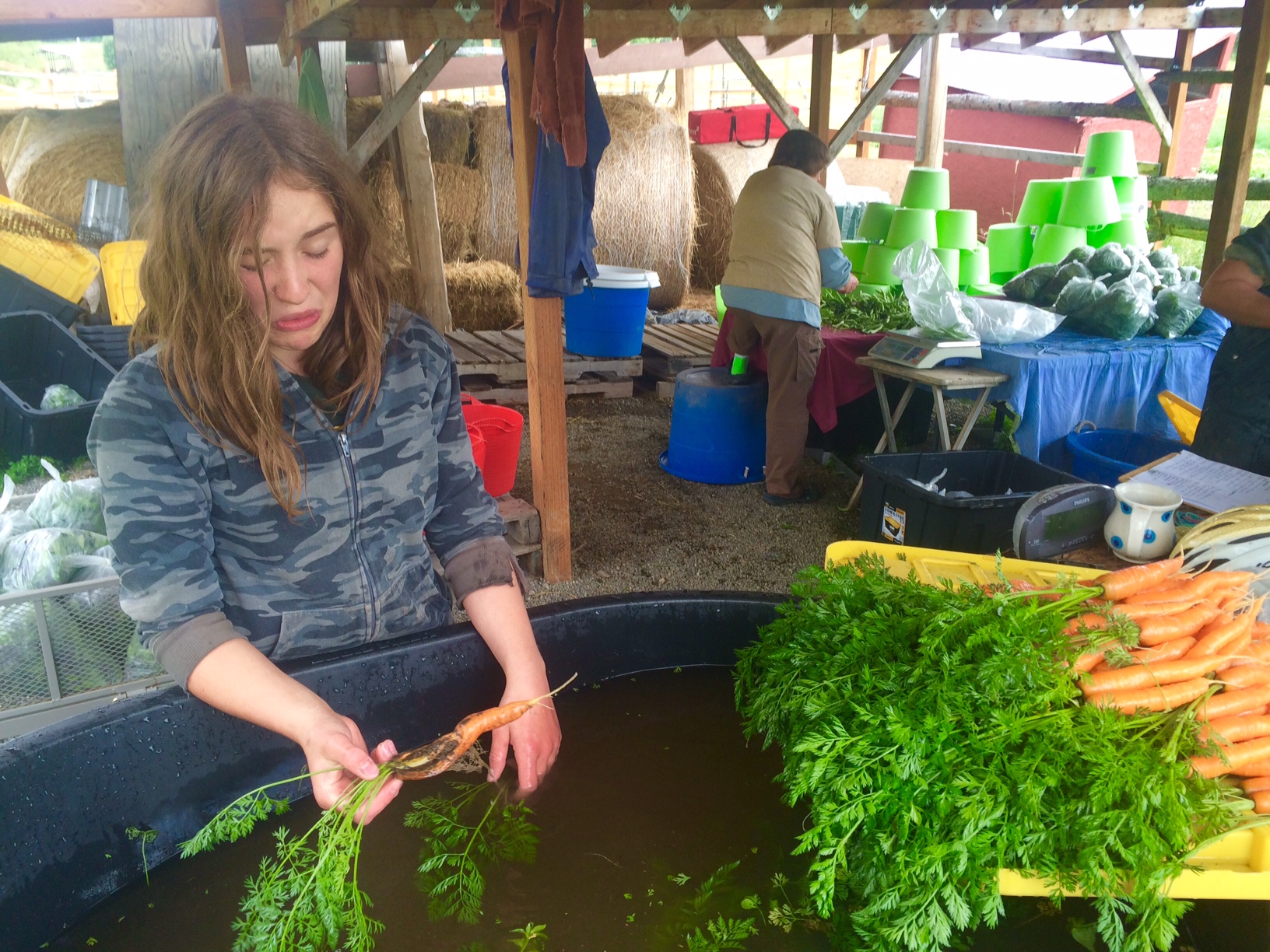 This is where we can really lose time if we don’t keep track of it. Roots need to be scrubbed and bunched, heads need to be trimmed, soaked and inspected, beans and peas need to be rinsed, weighed and bagged, and the fruits need to be rinsed and laid out to dry a little bit. I start with the fruits–zucchini and cucumbers–by giving them a quick scrub to get off any residual soil, flowers and the lovely slime they both release from their cut stems. I then place them on clean towels on the tables for their final spot before we put them in their CSA bins. I also count them another time to ensure we have enough. I then clean the washing bins they were in in preparation for cleaning the substitutions I had harvested. I clean and bunch the radishes and turnips and trim and soak the choi, cauliflower, peppers and cabbages. I have to go back to the field for more turnips because some of them have root maggot damage! argh!
This is where we can really lose time if we don’t keep track of it. Roots need to be scrubbed and bunched, heads need to be trimmed, soaked and inspected, beans and peas need to be rinsed, weighed and bagged, and the fruits need to be rinsed and laid out to dry a little bit. I start with the fruits–zucchini and cucumbers–by giving them a quick scrub to get off any residual soil, flowers and the lovely slime they both release from their cut stems. I then place them on clean towels on the tables for their final spot before we put them in their CSA bins. I also count them another time to ensure we have enough. I then clean the washing bins they were in in preparation for cleaning the substitutions I had harvested. I clean and bunch the radishes and turnips and trim and soak the choi, cauliflower, peppers and cabbages. I have to go back to the field for more turnips because some of them have root maggot damage! argh!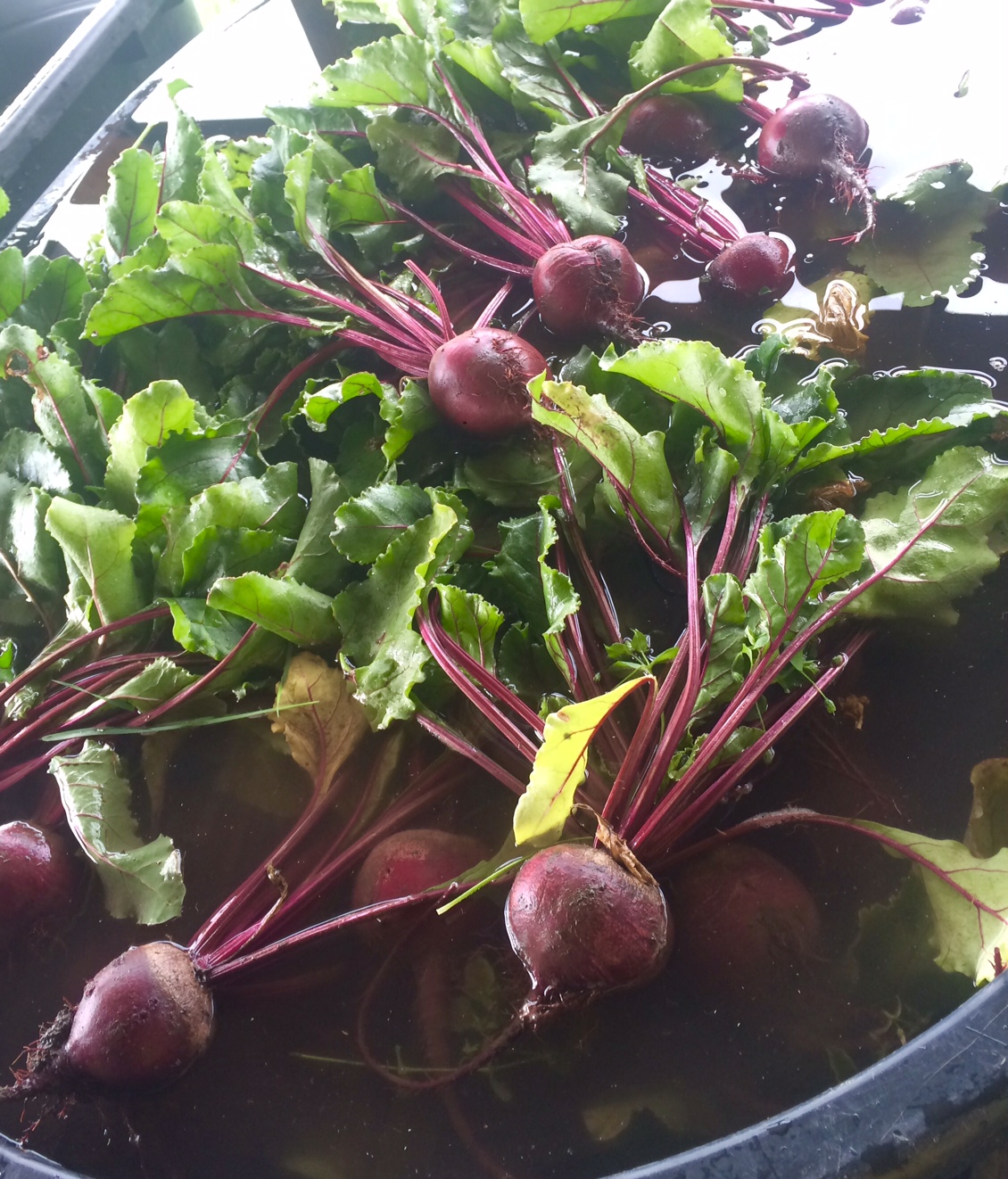
The spinach and onions are taken on by others as I move to help clean carrots with Trillium, who isn’t exactly excited to be cleaning them alone. The water isn’t as cold as I had worried, so that makes it a bit better. We scrub and scrub and scrub, all the while ensuring that the carrots are good looking. Carrots can be a bit picky when it comes to nutrients so some of them come out pretty funny looking with extra tips going this way and that, some of them hug one another and some look like bizarre sea creatures with numerous tentacles. We set the “uglies” aside for us to eat later!
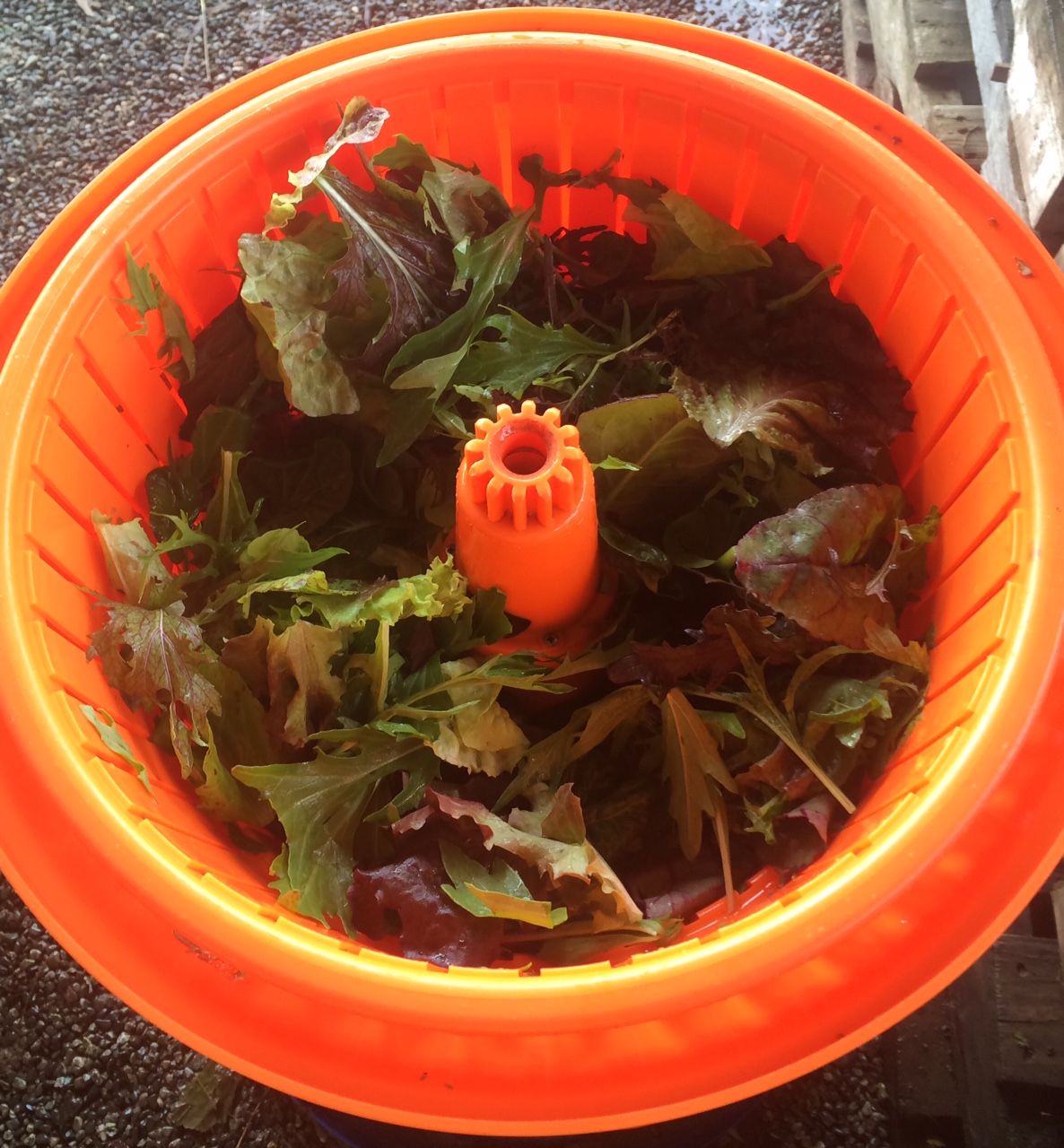
2:30 Almost ready for packing…
We are heading into the final stretch for getting all of the produce ready for packing. While the others finish processing the last bits, I ensure that all of the waste bins (where trimmings and the really “uglies” go to be fed to the pigs) are out of the harvest shed and out of our way, I clean off the pallets that we use to set all of the bins on and I set out the bins. We have three groups of bins: some stay on the farm for pick up, some go to Wasilla for pick up and the bins with substitutions get their own spot, too. I set up the non-sub bins while Trillium creates labels for the sub bins. We count everything over and over to make sure it is all good.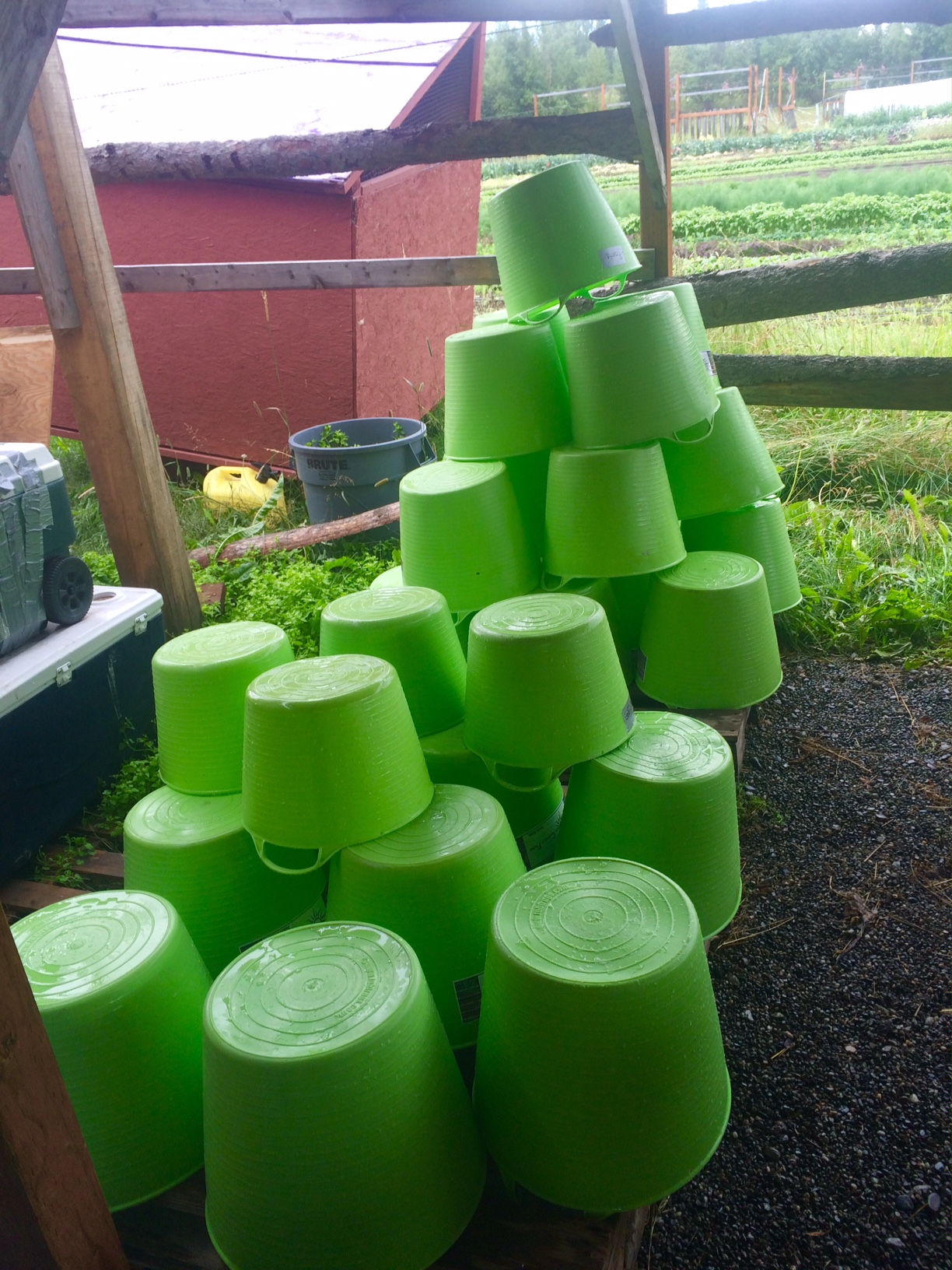
3:00 Packing time!
Trillium and her mom are in charge of the substitutions. I am in charge of the non subs. I have my own list of what produce goes in the large shares and what goes in the small. I number them in order of what should go in first through last. Heavy, hardy veggies go in first and we finish with the more delicate items. I dictate who packs what into which bins and it all goes fairly smoothly. We finish by packing up the truck! First round is for produce that stays on the farm but has to be transported to the farm stand for pick up. Second round is for the produce that heads to Wasilla. Anne-Corinne runs inside to change and print out newsletters and the rest of us start cleaning up the harvest shed.
4:00 The Truck heads off to Wasilla and On-Farm Pick-up Begins
We are often rushing at the very end of the day to ensure that we get shares out in time, but our timing was pretty good today. Still, I didn’t manage to get many photos at the end of the day. it gets hard with the constant moving and worrying about falling behind. Plus, it was rainy today so my camera was in a zipped up pocked on the inside of my rubber bibs–not the most convenient for taking quick shots.
Phew! I sit down and eat. It feels good to relax for a bit before heading home. We get to take home any extras or uglies that left behind, and we are encouraged to harvest anything else we want. Usually there is plenty in extras to keep everyone happy. Sometimes I go and pick a nice bouquet of flowers, but it starts raining today. So, I enjoy my late lunch while the rain falls on the roof above me. Ava wakes up from her nap, and we go home to eat some more!
CSA Days are non-stop harvesting days; but they are super fun, and we don’t have to weed! It is great to see some customers pick up their produce with big, healthy smiles. We are almost halfway done with this season, already. It’s hard to believe!
Do you have a CSA share? Have you ever worked in a situation like this? I really do love it and hope you enjoyed coming along for the ride, too.
Until next time,
Sending you peace and love from Alaska,
Alex, the Rural Farmgirl.





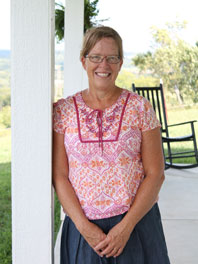
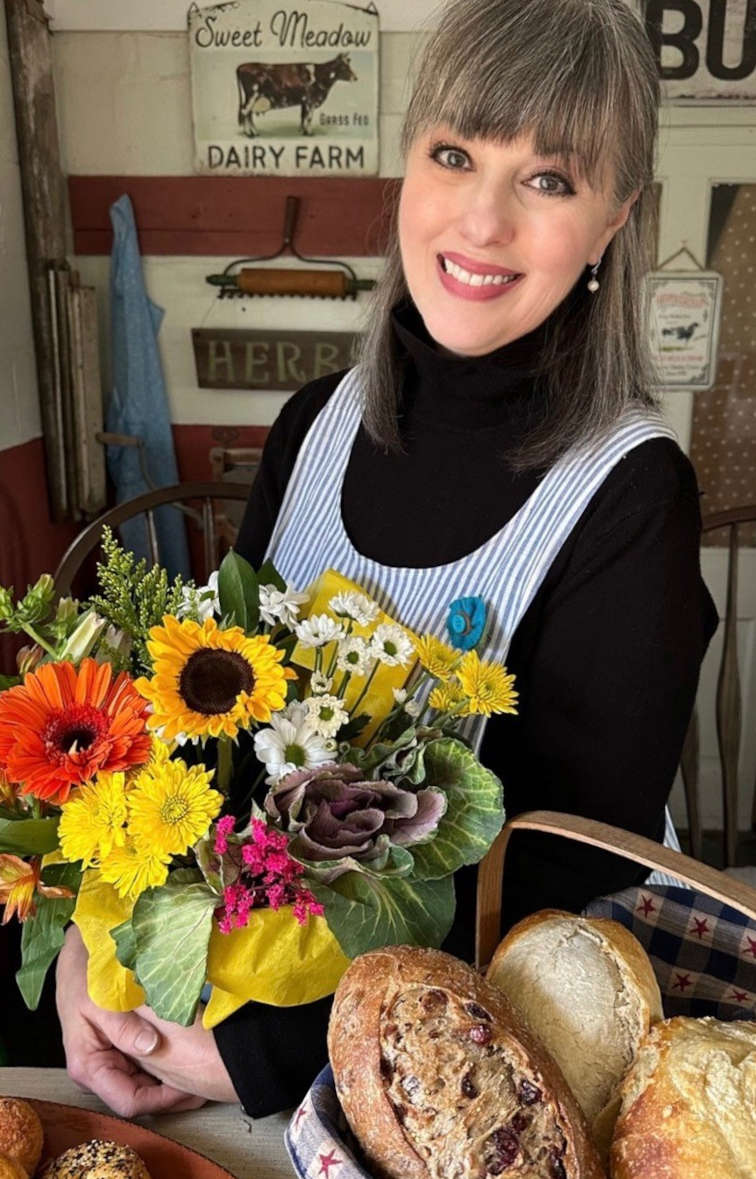
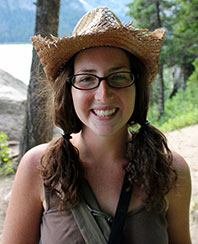
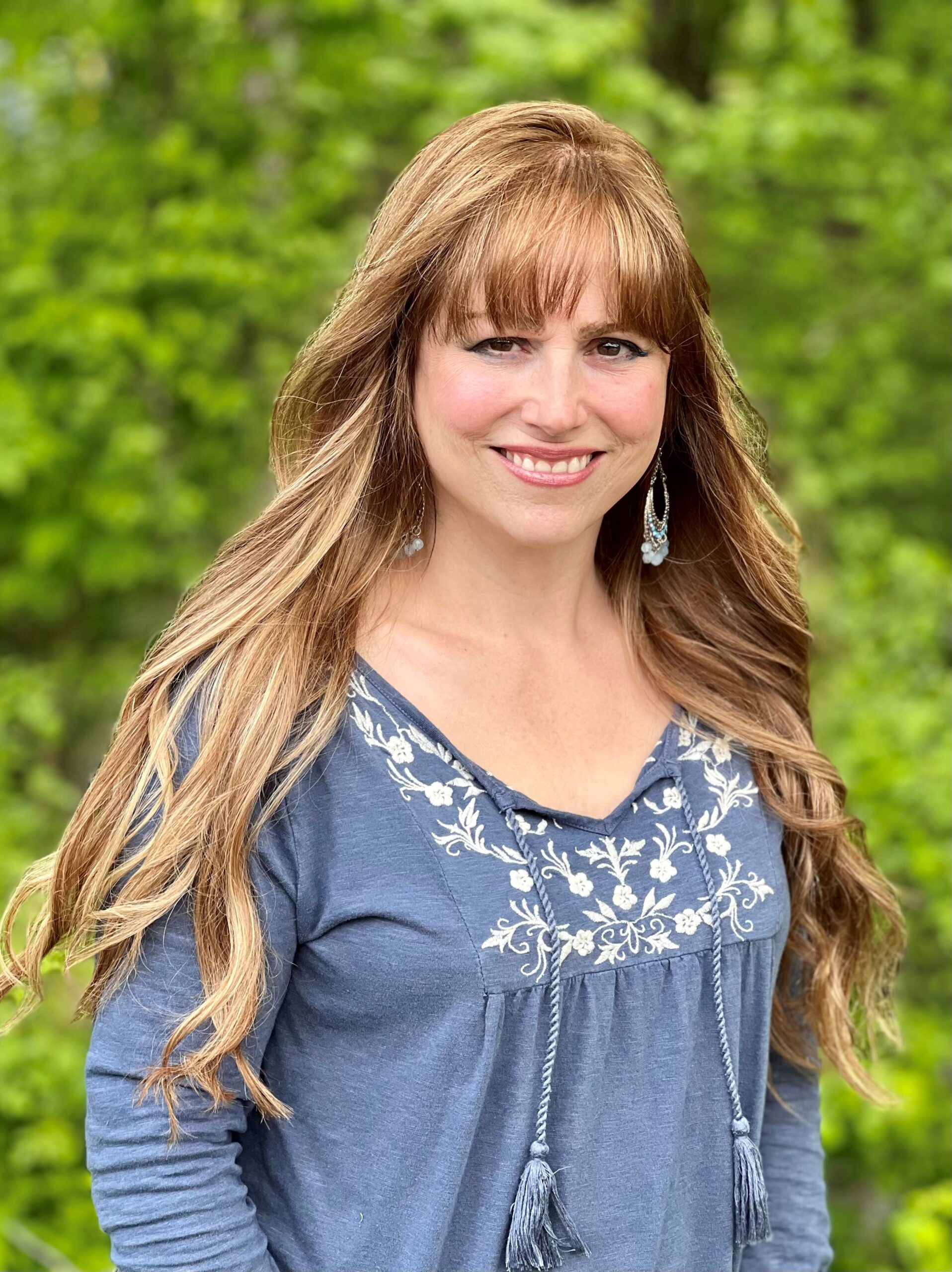


I work for a CSA in Ohio. It’s an awesome experience and my pay is a half share of veggies and a fruit share!
Alex, thank you for taking the time in a long work day to give such a detailed account of what happens on a CSA! I am a walnut farmer in rural northern California and have often wished I could run a market farm like yours. Reading your post gives me a better idea of the resources needed to make it happen. I got a lot out of it!
Aren’t we lucky to be farmers?!!
Oh, that’s great! I love that some of these posts can be a true resource for some. We ARE lucky to be farmers. I love my job and hope to keep it up for a long time. Is there any way we can get some of your walnuts? I’m kind of a walnut fiend!
Alex,
I’m so glad you wrote about this. I really enjoyed it. I don’t have a CSA as I have my own garden and to spare. But I’ve always kind of wondered about a CSA packing day! Those veggies look wonderful.
The most incredible part of your job is that you have Ava along with you. What a great experience you are providing her. And her friend Leila must be a sweetheart to help our with Ava! What great memories for her too.
Hugs,
– Dori, the Ranch Farmgirl –
Thanks, Dori. Packing day can be a big production–it’s hard to imagine how the farms that have hundreds (some have a thousand or more!!) of shares organize it all. I think many of them do one box at a time instead of one type of produce at a time like we do. And yes–I also think it is pretty incredible that Ava comes along with me. It wouldn’t be possible without Leila. I’d feel like I was neglecting Ava too much…but playing with friends while I’m preoccupied is great! Hugs to you and yours, as well.
I don’t know how you can I
Pick and take. Photos but your blog is always beautifully expressed a d. I enjoy it….seeing. you work as hard as. I do. For one person…..aNd give awAy my excess In exchange for things I can’t afford. This weem I gave. Away zucchini d got back on hand cream d some fruit from one person and loaf of. Italian bread from z other person anf some Keirig coffee a d lunch from a other. My garden is like having a FRIEND.WITH. BENEFITS.YOU. NEVER KNOW HOW YOU WILL. BE BLESSED.
Wow! Susana that is such a great bartering system. I miss days at the Farmer’s market and being able to do this. I’ll have my own little plot one day and it will be great fun to donate and barter with the excess! Thanks for sharing, as always.
We don’t have a CSA in our area but oh how nice it would be. I was raised on a farm in NE. where we grew much produce of which we canned, froze, jellied and jammed (jelly n jam was from the orchard). We rarely purchased from the super market, having “fresh” all year round was a huge treat and I miss it much. We do have Farmer’s Markets and we frequent them and that is nice. I so remember every day going to the gardens to harvest – peas one day, string beans the next, lettuce and the other greens along the way too – oh the tomatoes!!!! sweet corn and potatoes – goodness I haven’t had breakfast and all this food talk is making me hungry for a fresh vegie omelet (eggs from my sons chickens). Well thanks for the walk down memory lane and I do appreciate all the work you do – ain’t easy but so rewarding, body, mind n soul. God bless.
What amazing, vivid memories, Joan! Fresh, home grown veggies are SO tasty and good for our whole being. Thanks for sharing–hope your omelet was fantastic (but how could it not be?).
I devoured every detail of your post. So informative. It helps people appreciate the work involved. We used to grow massive amounts of carrots, planting them the first part of July so that we could cover them with straw for winter digging and they wouldn’t have grown too big. I remember one day in the winter when we were scrubbing them, the spray of water we were using was freezing everything as we worked. We looked like snowmen when we were done. Even our eye lashes were frozen white.
Your post is testament to how grateful we should be to those who feed us. It’s a tremendous amount of work. (Love the doll Ava is playing with:)
Thanks MaryJane! This isn’t even my intended post for today…rural internet is pretty great sometimes, as I’m sure you’re aware. However, I’m glad you got to read it! Farming in freezing temperatures definitely needs a hefty dose of good humors to make it worhtwhile–thanks for the vivid picture you’ve painted.
And isn’t that doll head hilarious!?! her farming friend, Leila, brings out the most hilarious toys to share with her. Great to hear from you, as always!
That is a LOT of work! When my mom and I ran a CSA, we didn’t scrub a darned thing. 🙂 Veggies that needed it got a rinse, but no more than that. We didn’t expect our veggies to look like the supermarket, and neither did our customers (thankfully!). We also had three “work days” or “farm visit days” when we’d put the kids to work helping to harvest potatoes. They didn’t mind the dirt, and worms, and loved turning the dirt with their hands to expose the potatoes. We would put them all in a big wire basket (about 4 foot by 4 foot with 5″ sides) and carry to the open and spray them off with a hose. We also weren’t great about weighing things, it was “a bag of this” and a “bunch of that.” We also included bouquets of wildflowers that I would go off and pick after we were done with veggies. We had about a dozen customers.